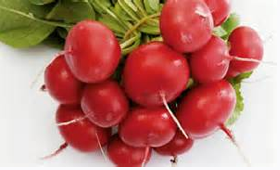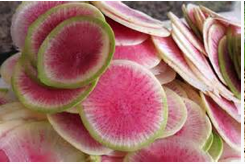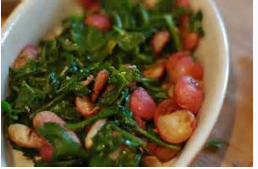by Catharine L. Kaufman — a.k.a. The Kitchen Shrink
Dear Kitchen Shrink:
I seem to like culinary challenges—such as buying unfamiliar produce even before I have a clue about their flavors or modes of preparation and discovering new ways to cook or serve old favorites. My quest now is for the latter, or more specifically, for a way to rescue the Radish from the obscurity of party platters where, carved into decorative rosettes, it is relegated to the humiliating role of disposable garnish. So, could you give this zippy-tasting root its due by revealing its history, varieties, nutritional benefits and some creative uses that place it in the spotlight?
Linda B.
La Jolla
/////////////////
How right you are. The radish does, indeed, deserve more respect, not to mention more versatile use than it has been given in recent years—even though in the past,it used to be an important component of meals throughout North America. It still commands, uninterruptedly, pride of place on the dinner tables of many other countries, where the considerable healing power and ability of this kick-in-the-pants root to dial up the flavors of foods with which it is served have always been well known and appreciated.
Radishes as Health Boosters
A member of the mighty anti-cancer warriors of the Brassicaceae family, the radish is related to such cruciferous powerhouses as cabbage, broccoli, cauliflower, horseradish and every health-conscious foodie’s latest darling, the versatile kale.
Besides having a zip-a-dee-doo-dah taste and satisfying crunch, radishes are rife with immune-boosting Vitamin C, folic acid, potassium, stress-busting B6, magnesium and bone-enhancing calcium. This low calorie carbohydrate (20 calories per cup) has also been prized for cooling internal heat, soothing sore throats, decongesting clogged sinuses and acting as a digestive aid that helps process foods and flush out toxins that cause bloating and other gastric distress. Packed with water, phosphorous and zinc, radishes will keep you well hydrated—which make them an excellent snack to take along on picnics and hikes—as well as plump up thirsty cells to give your complexion a healthy, youthful glow.
Root Surprise
Radishes come in a wide variety of colors, textures, shapes and sizes and contain different amounts of a plant chemical called ‘isothiocyanate,’ which determine their levels of pungency (or ‘heat’), as well as their subtle, mildly sweet or ‘spicy’ flavors.
Fall and win ter radish species include the mild-tasting, carrot-shaped, long, thick and pure white-fleshed Daikon (or Japanese) radish; round or elongated Black Spanish radish with rough black skin and hot peppery white flesh; Watermelon Radish, with an ordinary spherical shape and smooth white skin, which, when sliced, surprises with its inner flesh of vivid watermelon colors and design and makes a fine addition to smoothies and salads with its mild sweetness; the Green Radish, with its emerald pulp and sweet mellow flavor; and the California Mammoth White—a Daikon on steroids, growing 8 inches in length yet a gentle giant in its mild and refreshing flavor.
ter radish species include the mild-tasting, carrot-shaped, long, thick and pure white-fleshed Daikon (or Japanese) radish; round or elongated Black Spanish radish with rough black skin and hot peppery white flesh; Watermelon Radish, with an ordinary spherical shape and smooth white skin, which, when sliced, surprises with its inner flesh of vivid watermelon colors and design and makes a fine addition to smoothies and salads with its mild sweetness; the Green Radish, with its emerald pulp and sweet mellow flavor; and the California Mammoth White—a Daikon on steroids, growing 8 inches in length yet a gentle giant in its mild and refreshing flavor.
The spring and summer varieties include the well-known reddish-skinned Cherry Belles and Scarlet Globes with peppery white flesh; the mild and crispy French Breakfast, which fades from carmine to white at the elongated tips; the White Icicle, which resembles an albino carrot; and the hearty Plum Purple. Don’t miss out on the Easter Egg (which appears briefly in spring), a mixture of varieties sold in bunches combining white, red, pink and purple.
Cook’s tip: Pick firm, unblemished radishes with crisp, green leaves.
Radish Trivia
* Americans chow down on 400 million pounds of radishes a year—mostly served in salads—which are grown in California and Florida.
* From seed to salad in about 25 days, the fast-growing radish is a good choice for children’s gardens.
* Munching a radish has been known to cure hiccups.
Little Known Radish Facts and Tips
• While most people hasten to cut and toss the bushy greens attached to bunched radishes, those in the know, base their selections on the quality of both the roots and leaves. Thoroughly washed and carefully trimmed, the tender radish greens can be sautéed with olive oil and garlic for a peppery side dish, or juiced with your favorite fruits.
• Crush Daikons into a paste with mayo and Meyer lemon juice for a riff on cocktail sauce.
• Braise the tough-fleshed black root varieties with chicken broth, olive oil and red onions as a side dish for baked chicken or wild-caught salmon.
• Toss chunks in chicken or tortilla soup or stew.
• Give a splash of eye candy to Caesar, Cobb and Greek salads with strips of multi-colored radishes.
• Garnish libations or vegetable cocktails with radish fans or coins.
• Munch them raw dipped in herbed ricotta cheese.
• Chop a chutney blending radish, red onion, mango and lime juice and top off your favorite burger.
• Stuff a baked potato with a
puree of radish and sour cream.
• Shred any radish in a slaw or toss in a potato salad.
• Do Italian with radish and Romano risotto, radish and pesto bruschetta or top a pizza with the braised beauties.
• Whip up a refreshing radish sorbet
as an intermezzo or a breezy dessert with the sweeter watermelon radish.
• Or try this simple sweet and sour side that’ll add a healthful oomph to any mealL
Sweet and Sassy Radish Salad
3 bunches assorted radishes, coarsely chopped or smashed
2 1/2 tablespoons brown sugar
2 1/2 tablespoons apple cider vinegar or Meyer lemon juice
1 teaspoon toasted sesame oil
Sea salt to taste
Combine ingredients in a large bowl. Mix well and chill. Sprinkle with toasted sesame seeds and garnish with tender radish greens. Serve as a side for chicken, fish, quinoa or brown rice.



